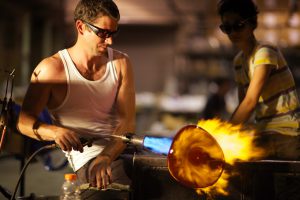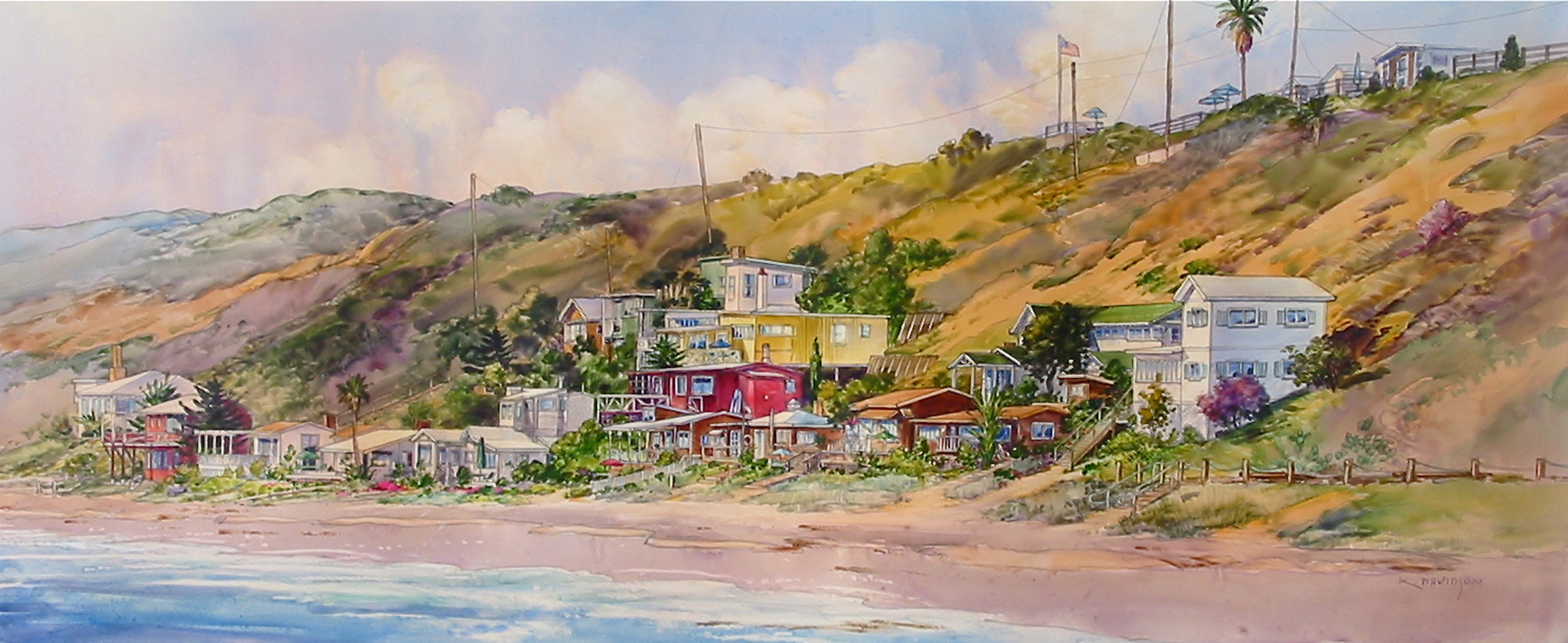Art That Mirrors Nature’s Changing Moods
One on One with Christopher Jeffries
By Gina Dostler
Christopher Jeffries has trained under many well-known artists to perfect his own style of glass-blown works of art with vibrant colors and shapes. He is one of the exhibitors featured at this year’s Festival of Arts in Laguna Beach. His Rock Wall series and other glass sculptures are displayed on the festival grounds.
Q: Where did you learn to make such beautiful glass work?
A: It’s constantly a learning process, but I was lucky to have been taught by many true artists. After I graduated from Chico State with a fine arts degree, emphasis in glass art, I went to study sculpture and design at Lorenzo De Medici in Florence, Italy. I followed it up with different established craft schools throughout North America working with artists of the highest caliber.
Q: You also apprenticed with quite a few well-known artists.
A: In the Czech Republic I apprenticed with master glassblower Igor Muller and acquired the fine techniques and designs I feel has inspired the direction of my career. I also apprenticed at the prestigious Boat House with Dale Chihuly. And also had the opportunity to teach with Steven Klein at the historic Corning Museum of Glass in New York.
Q: Working with glass has got to be a hot business, literally.
A: We work every day in a very hot environment. We always need a supply of melted glass on hand so we keep the furnace running all the time at 2,100 degrees Fahrenheit, created by a mixture of natural gas and oxygen that’s mixed through a burner. If we were to turn off the furnace it takes roughly three days to cool-off, with another three days to turn it back on. The furnace itself is insulated with high temperature brick. And inside is a ceramic pot that holds all the glass, anywhere from 300 to 1,000 lbs. Since the glass has to be filled 50 lbs at a time, we just can’t add it as we go. So we devote a whole day to melting fine glass, once a week to fill it up.
Q: Where does the glass come from?
A: We get it from North California and it is actually silica sand that looks like white powder. Under the high heat, it melts into a clear liquid. The sand is lead free, erbium based crystals. Erbium makes the glass more brilliant and reflective when it is lit with light. Melting high quality glass is an art in itself. There is so much involved in this process. It’s one of the reasons I love glass blowing; there are so many aspects to it.
Q: How much physical work does it take?
A: It’s very physical and labor-intensive working around glass. Once we start working on a piece we can’t stop until we are finished. So depending on the complexity and size of the piece, we can be working from a half-hour to three hours straight through. As soon as we finish, we basically start on the next one. We have a break for lunch and that’s about it. It’s definitely our way of staying fit!
Q: You keep mentioning “we.”
A: Glass-blowing is not done by one person alone. You’d be physically destroyed, and it would limit the designs we could produce. There is always a team to share the workload. I work in teams of three to produce my creations, making it a team oriented artistry. I use assistants for color applications and it helps me through the process. The team also takes turns heating the glass to shield me from the heat. And if I worked all by myself, it would simply limit what I could create. Teamwork is just another unique aspect of glassblowing and another reason that I love it and got pulled into this form of art.
Q: What gave you the idea for your Rock Wall series?
A: I received my inspiration from the Russian River in Northern California. I spent time visiting summers there as a kid. The riverbeds have huge layers of rock including the shoreline. One summer, watching the flow of the water over the smooth stones, we thought how cool it would be to create a piece of art inspired by the riverbed. I launched my first series in 2010 and developed it to what I have today, overlapping glass stones that use both color and dimension to playfully represent the river. The wall installations are a huge focal point of my work, and where I want my company to continue to go.
Q: And where is that?
A: A wall installation of glass versus accessories. In other words, as an artist, I’ve always wanted to work on a larger scale, to make a complete environment rather than individual components such as a vase to fill a niche or pedestal. The installations allow me to really create a mood with the color I choose to use, and effect the physical environment the artwork lives within.
Q: Why do you think the glass stones on the walls are so mesmerizing?
A: I think we all on some level identify with nature. The configuration of glass stones on the wall bring on a subconscious level the same sense of calm triggered by sights and sounds of water gently flowing down a river. And like a river’s bed of smooth stone, the sandblasted glass has a smooth satin finish that invites the viewer to come closer.
Q: How is light essential in your work?
A: By sandblasting the stones, the opaque quality allows the light to absorb in a different way. When lit, the color casts shadows and defuses the light in a different type of way than transparent glass. The wall lit at night becomes more dramatic. During the day, it glows with natural light, changing throughout the day. The wall is always flowing with different light and form, like the changing forms of a river over time.
CONTACT INFORMATION
Christopher Jeffries
Glassblowing Artist
1243 Victory Walk
Laguna Beach, California 92651
Contact # 949-228-7898
Website www.jeffriesglass.com
Email info@jeffriesglass.com



